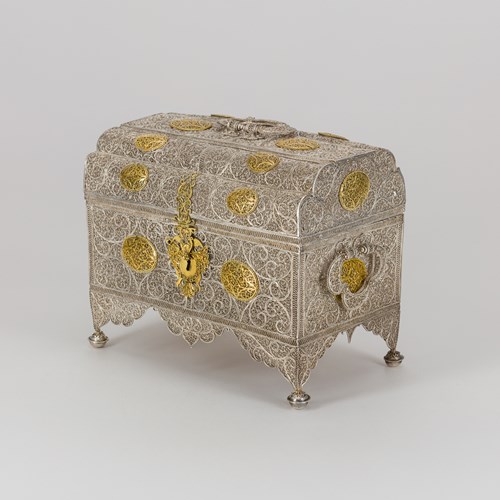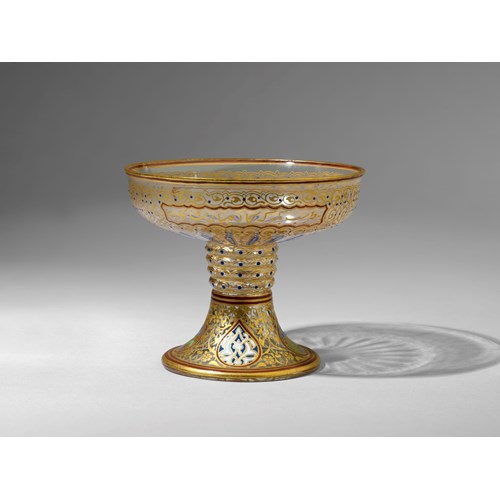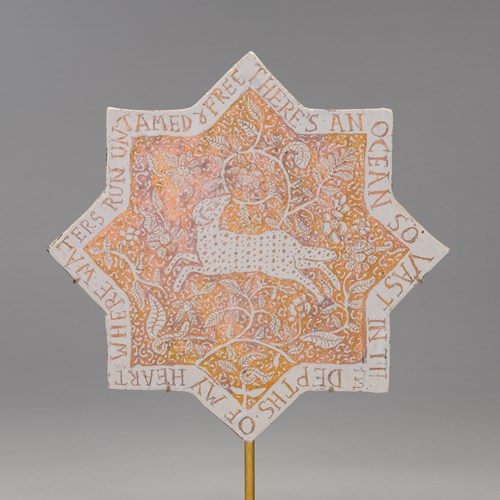A Study of a Small Buttonquail, Turnix sylvaticus
Date c.1800
Period Early 19th century
Origin Calcutta, India
Medium watercolour on J Whatman paper
Dimension 40 x 26 cm (15³/₄ x 10¹/₄ inches)
An unusual trait of the small buttonquail is that the females are polyandrous. Having laid four to five eggs, they will seek another mate, leaving the male to incubate the eggs and raise the chicks. Females also possess unique vocal organs, enabling them to produce long, deep calls, often made at dawn and dusk.
The present study depicts an alert small bird with stunningly intricate patterned feathers. The cryptic plumes of the upperparts consist of blacks and greys, with vivid flashes of cinnamon. The rufus chest feathers are interspersed with elegant black diamond patterns and the flanks and belly are greyish-white. Similar to the wings, the tail feathers are finely barred with quivering lines of black and chestnut, enhancing the bird’s ability to conceal itself amongst foliage. With its diminutive body and large feet, one can easily imagine this charming small bird scuttling amongst the dried grasses as it beadily hunts for seeds and insects. Through this lively and vibrant depiction of the buttonquail, the artist succeeds in reproducing the bird’s quaint and colourful character.
For additional ornithological studies made for Lord Valentia, see Sotheby’s Sven Gahlin Collection Lot 36 a drawing of a bustard, and Lot 37 a watercolour of a crow-pheasant, both made for Lord Valentia; Sotheby’s, London, 31 May 2011, The Stuart Cary Welch Collection, Part Two, lot 115; see also Welch 1976, no.26; Welch 1978-I, nos.18a-c.and Leach 1995, no.7.96, pp.760-2. For two bird studies donated by Viscount Valentia to Lord Wellesley, see British Library in London (Wellesley Collection, NHD 29, vol. iv, f.21,27)
Literature
Bikram Grewal et al. 2016. Birds of India - A Pictorial Field Guide. Om Books International.
Phil McGowan and Steve Madge. 2010. Pheasants, Partridges & Grouse: Including Buttonquails, Sandgrouse and Allies. Helm Identification Guides, Bloomsbury Publishing.
Stock no.: A5494
Date: c.1800
Period: Early 19th century
Origin: Calcutta, India
Medium: watercolour on J Whatman paper
Dimension: 40 x 26 cm (15³/₄ x 10¹/₄ inches)
Provenance:
George Annesley, 2nd Earl of Mountnorris and Viscount Valentia (1769-1844), was a passionate amateur naturalist with a particular interest in ornithology. Following a career in the army, he travelled to India in 1802 where, inspired by his encounters with professional botanists and zoologists, he commissioned a number of natural history paintings.
During his four-month residency with Saadat Ali Khan, Nawab of Oudh (r. 1798-1814), the Viscount was much enthused by the ruler’s additions to his ornithological collection; “he sent people into his woods to bring me rare birds and plants; he laid a dawk two hundred miles to bring them down to me in a state of perfection.” (Viscount Valentia, 1809, p. 172.)
In 1803 he stayed with Lord Wellesley (the elder brother of the first Duke of Wellington) and visited his menagerie in Barrackpore, Calcutta. Viscount Valentia gifted Wellesley two bird studies from his collection, now in the British Library, London (see M. Archer, Natural History Drawings in the India Office Library, London, 1962, p. 96). The works bear his personal Indian seal, “The Right Honourable Lord Bahadur Viscount Valentia.”
Returning to England in 1806, the Viscount became a member of parliament and wrote a three- volume series chronicling his travels, Voyages and Travels to India, Ceylon and the Red Sea, Abyssinia and Egypt in 1802-06. Published in 1809, the books were illustrated by his draughtsman and secretary Henry Salt. Continuing his interest in the natural world, Annesley became a member of the Royal Society and subsequently his collection has become the subject of an important series of natural history studies, celebrating India’s rich ecological biodiversity.
Of the current series of paintings, four bear the Viscount’s personal Indian seal, “The Right Honourable Lord Bahadur Viscount Valentia 1217 (1802-3)”, while three others have a seal in exactly the same ink as the works with a personal seal. Considering this and that the paintings display such a great likeness to one another, it is highly probable that they were commissioned by the Viscount and undertaken by the same artists. Drawing upon Mughal traditions of exceptionally intricate detail, rich colouration and masterful observation, Viscount Valentia’s artists successfully united this with European scientific taxonomy; achieving a sense of harmony between the romantic and the rational. Charming, informative and highly decorative, these works are a valuable example of the finest early nineteenth century Indian ornithological painting.
More artworks from the Gallery









